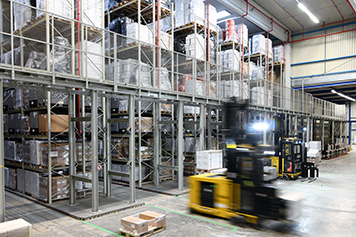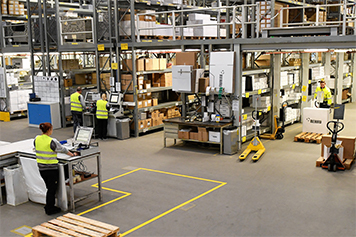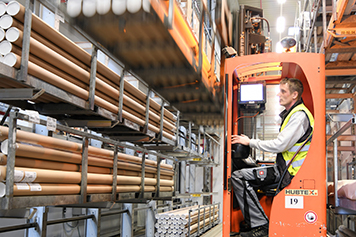Standard as strategic best practice in logistics
Warehouse management software at REHAU

To ensure that its IT architecture is standardised, polymer specialist Rehau relies on SAP EWM for warehouse and production logistics with direct SAP ERP integration. The roll-out to the sites is simplified by mean of a SAP EWM template in which the production and logistics processes of the Construction and Industry business units are mapped. In addition to this roll-out project, IGZ is responsible for planning and implementing two new automated warehouses.
In the period of reconstruction after the Second World War, creativity and a "get-it-done mentality" were more in demand than ever. Helmut Wagner likewise didn't waste any time, and in 1948 he started producing plastic water hoses and piping in Rehau in Upper Franconia. Following this, the first products for the automotive industry were manufactured, including assist straps and running boards for the legendary VW Beetle. As a premium brand for polymer-based solutions, the Rehau Group is now a leader in the construction, automotive and industrial sectors. Around 20,000 employees at 170 locations worldwide contribute to the success of the independent family-owned company, which has an annual turnover of more than three billion euros.
Future viability and efficiency ensured by standard software for logistics
Instead of short-term profit maximisation, the corporate philosophy stipulates stringent orientation towards medium and long-term goals. This is also how the REHAU Best Practice (RBP) project came into being: All business processes are planned for gradual conversion to SAP standard software, thereby systematically driving the digital transformation. Commenting on the implementation of SAP ERP for Construction + Industry (Mill Solution) and SAP EWM, Ralf Zeising, Head of IBS Logistics Construction/Industry, said: "We’re aiming for end-to-end IT architecture standardisation and IT resource scaling. As a consequence, having an open warehouse management platform that is S/4-ready and available as standard to all companies within the Rehau Group is mandatory."
In light of this, LAWI, a self-developed warehouse management software that was more than 18 years old and could no longer cover current and future requirements, also had to be replaced. 17 locations were affected by this measure. The use of SAP WM (SAP Warehouse Management) in some branches also became associated with growing risks, as SAP has announced its intention to discontinue support in 2027. Instead, Rehau favours SAP EWM as a solution integrated into the core of the SAP S/4HANA business suite.
Continuation of proven partnership with IGZ

The polymer specialist enlisted the support of IGZ, the SAP engineers from Falkenberg in the Upper Palatinate for the first time in 2009. Since then, several SAP projects have been launched and successfully finalised in close cooperation, including the implementation of SAP EWM in São Paulo, Brazil, and in Triptis, Thuringia. As an SAP EWM general contractor, IGZ is also pushing ahead with the implementation of two new automatic warehouses in Triptis and Visbek, whose warehouse technology will be controlled via the SAP MFS (SAP Material Flow System) module integrated in SAP EWM without intermediate layers or legacy software. This allows Rehau to save on additional systems.
"The positive experience we had with our previous cooperation spoke in favour of IGZ", Ralf Zeising stresses. "With regard to the automation projects, it was of course also important have the support of a reliable partner who can demonstrate sufficient experience as a responsible general contractor for the planning and implementation of such intralogistics systems. And then there is also the specialist knowledge required to successfully master roll-out projects at an international level."
Template process proves to be a success factor
The taken approach began with the development of an SAP EWM template that is generally valid for the specialisms of construction and industry and that, as a "copyable" template or preconfigured warehouse management system, simplifies the roll-out across national borders. Once the template had been created, it could be further developed on a site-specific basis. Globally, the focus is on functional/process-related areas such as incoming and outgoing goods, picking, characteristic and batch-based inventory management, quality control and MES-supported production, mobile RF (radio frequency) devices, portable and web-based dialogs as well as delivery note and label printing.
"The technology is not primarily the decisive factor for successful implementation, the project methodology also plays a major role," says IGZ division manager Stefan Wittmann. "A template with copyable and adaptable functions and processes saves time and money and minimises risks during implementation." Provided they have their own IT expertise, customers like Rehau can handle the further roll-out on their own and carry out future optimisations without any major loss of time. If desired, IGZ is only temporarily active as a consultant for roll-outs, and this is also the case for remote procedures.
SAP EWM implementation has a positive impact
The template development was preceded by a rough concept phase, during which IGZ also carried out an SAP-EWM deployment analysis. This was followed by the SAP EWM/MFS specification phase and the subsequent support during implementation, test runs and go-live. Among the sites that have been converted to SAP EWM between 2018 and 2019 were São Paulo (Brazil) and Triptis, as well as two branches in Spain.
SAP ERP and SAP EWM were implemented in São Paulo in early 2018 as part of the RBP. The goal was to closely interlink production and logistics and control the entire process chain via SAP standard software. At the same time, replacing the rudimentary warehouse management system that was previously in use has brought paper-based processes into the digital age, thereby reducing logistics costs. One further advantage is that it is now also possible to meet the "Nota Fiscal" (tax law that applies in Brazil and is sometimes difficult to understand) in a fully automated manner using electronics.
The go-live went ahead in Triptis virtually at the same time. Rehau has a production plant there with an adjoining logistics centre, which has already been expanded several times. As part of the RBP, SAP EWM replaced the outdated LAWI warehouse management software and now also communicates with Rehau's own Manufacturing Execution System EVF without any media discontinuity. One specific feature is the use of multifunction terminals (MFT). All applications run on this web-based user interface developed by Rehau. In SAP EWM, this triggers things such as component requests and returns, consumption postings and the additional posting of finished goods. "We’ve adapted the SAP dialogs to these MFT frames: a clear indication of how flexibly the standard software can also run in other individually designed environments," Stefan Wittmann stresses.
![[Translate to English:] Ralf Zeising - REHAU | IGZ [Translate to English:] Ralf Zeising - REHAU | IGZ](/fileadmin/_processed_/3/f/csm_igz-rehau-zitat_89e4591e20.jpg)
"We're aiming for end-to-end IT architecture standardisation and IT resource scaling."
Ralf Zeising, Head of IBS Logistics Construction/Industry at Rehau
Coherent, visually supported dialog management

Picking and packing dialogs are also integrated. Among other things, this makes picking according to planned HUs (handling units) including package optimisation possible. This ‘Case Calculation’ is automatically called up at the delivery facility in the ERP, via which the planned HUs are generated in the ERP with the help of algorithms. These are transferred to SAP EWM and then authorised for picking. "The advantage of this process is that it significantly simplifies subsequent physical creation of the handling units, and the resource utilisation in the warehouse and during transport is already determined at an early stage and can therefore be better planned," adds Wittmann. Since SAP TM (SAP Transportation Management) also accesses the Case Calculation in SAP ERP ECC Mill Solution, transportation processing knows about the expected HUs at the same time. Employees are additionally supported by the EWM packing table, which is directly integrated in SAP and shows them which items need to be packed and how. The appropriate packaging materials are identified by means of scanning and the labels and delivery documents that will be attached to the handling units can also be generated automatically. Another highlight of the process is stock determination using batch selection characteristics in the SAP standard.
Full steam ahead for automation
An increase in storage capacities and a further improvement in picking performance are currently on the agenda. To achieve this, the polymer specialist is continuing to invest in plant expansion and two new automated warehouses in Triptis. The pallet warehouse went live in November 2020, right on schedule. If everything goes according to plan, the second automated system, which primarily serves as a picking buffer, will be ready to go live in 2021. IGZ is also planning and implementing this solution as SAP-EWM general contractor. In addition to plant and PLC control technology, the SAP engineers are also responsible for implementing SAP EWM including integrated material flow control (SAP MFS) and direct ERP integration.
IT and process platform levelled across locations
"The created template has significantly accelerated the roll-out of SAP EWM to our domestic and foreign sites and minimised implementation risks, which can never be completely ruled out," says Rehau’s Head of IBS Logistics Construction/Industry Ralf Zeising to summarise. "At the same time, the constantly required specific adjustments in the case of the new warehouse in Triptis (which was designed for automatic control) were at a very special level.” Currently, the template is being used as a design template for the roll-out of the software to more than 20 Rehau construction/industry locations. Sticking to the RBP approach, the company is thus creating the conditions for a standardised and future-proof IT and process platform throughout the Group, which can be used to react flexibly to market changes. "Together with IGZ, we have mastered this in the best possible way. This is also down to the fact that our own SAP experts have successively built up new expertise, so that we can operate largely autonomously in day-to-day practice," says Zeising. He and his team are also acting with foresight with regard to the emerging S/4 era: because, as an embedded version, SAP EWM can also be used as a central warehouse management platform within the new ERP generation SAP S/4HANA.
Back to overview

